Table of Contents
Related pages
See also
Introduction
The unemployment rate is probably the best-known labour market measure and is certainly one of the most widely quoted by the media. The unemployment rate is a useful measure of the underutilization of the labour supply. It reflects the inability of an economy to generate employment for those persons who want to work but are not doing so, even though they are available for employment and actively seeking work.
Other measures of labour underutilization recognized in the international statistical standards are time-related underemployment and the potential labour force.
Data catalogue
| Indicator | Frequency | Database | Subject | Download (with labels) | Download (with codes) | Data explorer |
|---|---|---|---|---|---|---|
| SDG indicator 8.5.2 - Unemployment rate (%) | Annual | SDG Labour Market Indicators (ILOSDG) | Unemployment | .csv .dta .xlsx | .csv.gz | |
| SDG indicator 8.5.2 - Unemployment rate by disability status (%) | Annual | SDG Labour Market Indicators (ILOSDG) | Unemployment | .csv .dta .xlsx | .csv.gz | |
| SDG indicator 8.6.1 - Proportion of youth (aged 15-24 years) not in education, employment or training | Annual | SDG Labour Market Indicators (ILOSDG) | Other measures of labour underutilization | .csv .dta .xlsx | .csv.gz | |
| Unemployment by sex and age (thousands) | Annual | Labour Force Statistics (LFS) | Unemployment | .csv .dta .xlsx | .csv.gz | |
| Unemployment by sex and age (thousands) | Quarterly | Short-Term Labour Force Statistics (STLFS) | Unemployment | .csv .dta .xlsx | .csv.gz | |
| Unemployment by sex and age (thousands) | Monthly | Short-Term Labour Force Statistics (STLFS) | Unemployment | .csv .dta .xlsx | .csv.gz | |
| Unemployment by sex, age and education (thousands) | Annual | Education and Mismatch Indicators (EMI) | Unemployment | .csv .dta | .csv.gz | |
| Unemployment by sex, age and education (thousands) | Quarterly | Short-Term Labour Force Statistics (STLFS) | Unemployment | .csv .dta | .csv.gz | |
| Unemployment by sex, age and education (thousands) | Monthly | Short-Term Labour Force Statistics (STLFS) | Unemployment | .csv .dta .xlsx | .csv.gz | |
| Unemployment by sex, age and rural / urban areas (thousands) | Annual | Rural and Urban Labour Markets (RURBAN) | Unemployment | .csv .dta .xlsx | .csv.gz | |
| Unemployment by sex, age and rural / urban areas (thousands) | Quarterly | Short-Term Labour Force Statistics (STLFS) | Unemployment | .csv .dta .xlsx | .csv.gz | |
| Unemployment by sex, age and rural / urban areas (thousands) | Monthly | Short-Term Labour Force Statistics (STLFS) | Unemployment | .csv .dta .xlsx | .csv.gz | |
| Unemployment by sex, age and marital status (thousands) | Annual | Gender Equality and Non-Discrimination Indicators (GEND) | Unemployment | .csv .dta .xlsx | .csv.gz | |
| Unemployment by sex, age and marital status (thousands) | Quarterly | Short-Term Labour Force Statistics (STLFS) | Unemployment | .csv .dta .xlsx | .csv.gz | |
| Unemployment by sex, age and disability status (thousands) | Annual | Disability Labour Market Indicators (DLMI) | Unemployment | .csv .dta .xlsx | .csv.gz | |
| Unemployment by sex and education (thousands) | Annual | Education and Mismatch Indicators (EMI) | Unemployment | .csv .dta .xlsx | .csv.gz | |
| Unemployment by sex and education (thousands) | Quarterly | Short-Term Labour Force Statistics (STLFS) | Unemployment | .csv .dta .xlsx | .csv.gz | |
| Unemployment by sex and education (thousands) | Monthly | Short-Term Labour Force Statistics (STLFS) | Unemployment | .csv .dta .xlsx | .csv.gz | |
| Unemployment by sex, education and rural / urban areas (thousands) | Annual | Education and Mismatch Indicators (EMI) | Unemployment | .csv .dta .xlsx | .csv.gz | |
| Unemployment by sex, education and rural / urban areas (thousands) | Quarterly | Short-Term Labour Force Statistics (STLFS) | Unemployment | .csv .dta .xlsx | .csv.gz | |
| Unemployment by sex, education and marital status (thousands) | Annual | Education and Mismatch Indicators (EMI) | Unemployment | .csv .dta .xlsx | .csv.gz | |
| Unemployment by sex, education and disability status (thousands) | Annual | Disability Labour Market Indicators (DLMI) | Unemployment | .csv .dta .xlsx | .csv.gz | |
| Unemployment by sex and rural / urban areas (thousands) | Annual | Rural and Urban Labour Markets (RURBAN) | Unemployment | .csv .dta .xlsx | .csv.gz | |
| Unemployment by sex and rural / urban areas (thousands) | Quarterly | Short-Term Labour Force Statistics (STLFS) | Unemployment | .csv .dta .xlsx | .csv.gz | |
| Unemployment by sex and rural / urban areas (thousands) | Monthly | Short-Term Labour Force Statistics (STLFS) | Unemployment | .csv .dta .xlsx | .csv.gz | |
| Unemployment by sex, rural / urban area and marital status (thousands) | Annual | Rural and Urban Labour Markets (RURBAN) | Unemployment | .csv .dta .xlsx | .csv.gz | |
| Unemployment by sex, rural / urban area and marital status (thousands) | Quarterly | Short-Term Labour Force Statistics (STLFS) | Unemployment | .csv .dta .xlsx | .csv.gz | |
| Unemployment by sex and marital status (thousands) | Annual | Gender Equality and Non-Discrimination Indicators (GEND) | Unemployment | .csv .dta .xlsx | .csv.gz | |
| Unemployment by sex and marital status (thousands) | Quarterly | Short-Term Labour Force Statistics (STLFS) | Unemployment | .csv .dta .xlsx | .csv.gz | |
| Unemployment by sex and marital status (thousands) | Monthly | Short-Term Labour Force Statistics (STLFS) | Unemployment | .csv .dta .xlsx | .csv.gz | |
| Unemployment by sex, rural / urban areas and disability status (thousands) | Annual | Disability Labour Market Indicators (DLMI) | Unemployment | .csv .dta .xlsx | .csv.gz | |
| Unemployment by sex, rural / urban areas and disability status (thousands) | Quarterly | Short-Term Labour Force Statistics (STLFS) | Unemployment | .csv .dta .xlsx | .csv.gz | |
| Unemployment by sex and disability status (thousands) | Annual | Disability Labour Market Indicators (DLMI) | Unemployment | .csv .dta .xlsx | .csv.gz | |
| Unemployment by sex, marital status and disability status (thousands) | Annual | Disability Labour Market Indicators (DLMI) | Unemployment | .csv .dta .xlsx | .csv.gz | |
| Unemployment by sex, marital status and disability status (thousands) | Quarterly | Short-Term Labour Force Statistics (STLFS) | Unemployment | .csv .dta .xlsx | .csv.gz | |
| Unemployment by sex, age and duration (thousands) | Annual | Labour Force Statistics (LFS) | Unemployment | .csv .dta | .csv.gz | |
| Unemployment by sex, age and duration (thousands) | Quarterly | Short-Term Labour Force Statistics (STLFS) | Unemployment | .csv .dta | .csv.gz | |
| Unemployment by sex, age and duration (thousands) | Monthly | Short-Term Labour Force Statistics (STLFS) | Unemployment | .csv .dta .xlsx | .csv.gz | |
| Unemployment by sex, duration and rural / urban areas (thousands) | Annual | Rural and Urban Labour Markets (RURBAN) | Unemployment | .csv .dta .xlsx | .csv.gz | |
| Unemployment by sex, duration and marital status (thousands) | Annual | Gender Equality and Non-Discrimination Indicators (GEND) | Unemployment | .csv .dta .xlsx | .csv.gz | |
| Unemployment of previously employed persons by sex and former economic activity (thousands) | Annual | Labour Force Statistics (LFS) | Unemployment | .csv .dta .xlsx | .csv.gz | |
| Unemployment of previously employed persons by sex, former economic activity and education (thousands) | Annual | Education and Mismatch Indicators (EMI) | Unemployment | .csv .dta .xlsx | .csv.gz | |
| Unemployment of previously employed persons by sex and former occupation (thousands) | Annual | Labour Force Statistics (LFS) | Unemployment | .csv .dta .xlsx | .csv.gz | |
| Unemployment by sex, occupation and education (thousands) | Annual | Education and Mismatch Indicators (EMI) | Unemployment | .csv .dta .xlsx | .csv.gz | |
| Unemployment by sex and categories of unemployed persons (thousands) | Annual | Labour Force Statistics (LFS) | Unemployment | .csv .dta .xlsx | .csv.gz | |
| Unemployment by sex and categories of unemployed persons (thousands) | Quarterly | Short-Term Labour Force Statistics (STLFS) | Unemployment | .csv .dta .xlsx | .csv.gz | |
| Unemployment by sex and age, seasonally adjusted series (thousands) | Quarterly | Short-Term Labour Force Statistics (STLFS) | Unemployment | .csv .dta .xlsx | .csv.gz | |
| Unemployment by sex and age, seasonally adjusted series (thousands) | Monthly | Short-Term Labour Force Statistics (STLFS) | Unemployment | .csv .dta .xlsx | .csv.gz | |
| Unemployment by sex, age and duration, seasonally adjusted series (thousands) | Quarterly | Short-Term Labour Force Statistics (STLFS) | Unemployment | .csv .dta .xlsx | .csv.gz | |
| Unemployment rate by sex and age (%) | Annual | Labour Force Statistics (LFS) | Unemployment | .csv .dta .xlsx | .csv.gz | |
| Unemployment rate by sex and age (%) | Quarterly | Short-Term Labour Force Statistics (STLFS) | Unemployment | .csv .dta .xlsx | .csv.gz | |
| Unemployment rate by sex and age (%) | Monthly | Short-Term Labour Force Statistics (STLFS) | Unemployment | .csv .dta .xlsx | .csv.gz | |
| Unemployment rate by sex, age and education (%) | Annual | Education and Mismatch Indicators (EMI) | Unemployment | .csv .dta | .csv.gz | |
| Unemployment rate by sex, age and education (%) | Quarterly | Short-Term Labour Force Statistics (STLFS) | Unemployment | .csv .dta | .csv.gz | |
| Unemployment rate by sex, age and education (%) | Monthly | Short-Term Labour Force Statistics (STLFS) | Unemployment | .csv .dta .xlsx | .csv.gz | |
| Unemployment rate by sex, age and rural / urban areas (%) | Annual | Rural and Urban Labour Markets (RURBAN) | Unemployment | .csv .dta .xlsx | .csv.gz | |
| Unemployment rate by sex, age and rural / urban areas (%) | Quarterly | Short-Term Labour Force Statistics (STLFS) | Unemployment | .csv .dta .xlsx | .csv.gz | |
| Unemployment rate by sex, age and rural / urban areas (%) | Monthly | Short-Term Labour Force Statistics (STLFS) | Unemployment | .csv .dta .xlsx | .csv.gz | |
| Unemployment rate by sex, age and marital status (%) | Annual | Gender Equality and Non-Discrimination Indicators (GEND) | Unemployment | .csv .dta .xlsx | .csv.gz | |
| Unemployment rate by sex, age and marital status (%) | Quarterly | Short-Term Labour Force Statistics (STLFS) | Unemployment | .csv .dta .xlsx | .csv.gz | |
| Unemployment rate by sex, age and disability status (%) | Annual | Disability Labour Market Indicators (DLMI) | Unemployment | .csv .dta .xlsx | .csv.gz | |
| Unemployment rate by sex and education (%) | Annual | Education and Mismatch Indicators (EMI) | Unemployment | .csv .dta .xlsx | .csv.gz | |
| Unemployment rate by sex and education (%) | Quarterly | Short-Term Labour Force Statistics (STLFS) | Unemployment | .csv .dta .xlsx | .csv.gz | |
| Unemployment rate by sex and education (%) | Monthly | Short-Term Labour Force Statistics (STLFS) | Unemployment | .csv .dta .xlsx | .csv.gz | |
| Unemployment rate by sex, education and rural / urban areas (%) | Annual | Education and Mismatch Indicators (EMI) | Unemployment | .csv .dta .xlsx | .csv.gz | |
| Unemployment rate by sex, education and rural / urban areas (%) | Quarterly | Short-Term Labour Force Statistics (STLFS) | Unemployment | .csv .dta .xlsx | .csv.gz | |
| Unemployment rate by sex, education and marital status (%) | Annual | Education and Mismatch Indicators (EMI) | Unemployment | .csv .dta .xlsx | .csv.gz | |
| Unemployment rate by sex, education and disability status (%) | Annual | Disability Labour Market Indicators (DLMI) | Unemployment | .csv .dta .xlsx | .csv.gz | |
| Unemployment rate by sex and rural / urban areas (%) | Annual | Rural and Urban Labour Markets (RURBAN) | Unemployment | .csv .dta .xlsx | .csv.gz | |
| Unemployment rate by sex and rural / urban areas (%) | Quarterly | Short-Term Labour Force Statistics (STLFS) | Unemployment | .csv .dta .xlsx | .csv.gz | |
| Unemployment rate by sex and rural / urban areas (%) | Monthly | Short-Term Labour Force Statistics (STLFS) | Unemployment | .csv .dta .xlsx | .csv.gz | |
| Unemployment rate by sex, rural / urban area and marital status (%) | Annual | Rural and Urban Labour Markets (RURBAN) | Unemployment | .csv .dta .xlsx | .csv.gz | |
| Unemployment rate by sex, rural / urban area and marital status (%) | Quarterly | Short-Term Labour Force Statistics (STLFS) | Unemployment | .csv .dta .xlsx | .csv.gz | |
| Unemployment rate by sex, rural / urban areas and disability status (%) | Annual | Disability Labour Market Indicators (DLMI) | Unemployment | .csv .dta .xlsx | .csv.gz | |
| Unemployment rate by sex, rural / urban areas and disability status (%) | Quarterly | Short-Term Labour Force Statistics (STLFS) | Unemployment | .csv .dta .xlsx | .csv.gz | |
| Unemployment rate by sex and marital status (%) | Annual | Gender Equality and Non-Discrimination Indicators (GEND) | Unemployment | .csv .dta .xlsx | .csv.gz | |
| Unemployment rate by sex and marital status (%) | Quarterly | Short-Term Labour Force Statistics (STLFS) | Unemployment | .csv .dta .xlsx | .csv.gz | |
| Unemployment rate by sex and marital status (%) | Monthly | Short-Term Labour Force Statistics (STLFS) | Unemployment | .csv .dta .xlsx | .csv.gz | |
| Unemployment rate by sex and disability status (%) | Annual | Disability Labour Market Indicators (DLMI) | Unemployment | .csv .dta .xlsx | .csv.gz | |
| Unemployment rate by sex, marital status and disability status (%) | Annual | Disability Labour Market Indicators (DLMI) | Unemployment | .csv .dta .xlsx | .csv.gz | |
| Unemployment rate by sex, marital status and disability status (%) | Quarterly | Short-Term Labour Force Statistics (STLFS) | Unemployment | .csv .dta .xlsx | .csv.gz | |
| Unemployment rate by sex and age, seasonally adjusted series (%) | Quarterly | Short-Term Labour Force Statistics (STLFS) | Unemployment | .csv .dta .xlsx | .csv.gz | |
| Unemployment rate by sex and age, seasonally adjusted series (%) | Monthly | Short-Term Labour Force Statistics (STLFS) | Unemployment | .csv .dta .xlsx | .csv.gz | |
| Prime-age unemployment rate by sex, household type and presence of children (%) | Annual | Gender Equality and Non-Discrimination Indicators (GEND) | Unemployment | .csv .dta .xlsx | .csv.gz | |
| Prime-age unemployment rate by sex, household type and rural / urban areas (%) | Annual | Gender Equality and Non-Discrimination Indicators (GEND) | Unemployment | .csv .dta .xlsx | .csv.gz | |
| Combined rate of time-related underemployment and unemployment (LU2) by sex and age (%) | Annual | Labour Force Statistics (LFS) | Other measures of labour underutilization | .csv .dta .xlsx | .csv.gz | |
| Combined rate of time-related underemployment and unemployment (LU2) by sex and age (%) | Quarterly | Short-Term Labour Force Statistics (STLFS) | Other measures of labour underutilization | .csv .dta .xlsx | .csv.gz | |
| Combined rate of time-related underemployment and unemployment (LU2) by sex and age (%) | Monthly | Short-Term Labour Force Statistics (STLFS) | Other measures of labour underutilization | .csv .dta .xlsx | .csv.gz | |
| Combined rate of time-related underemployment and unemployment (LU2) by sex, age and education (%) | Annual | Education and Mismatch Indicators (EMI) | Other measures of labour underutilization | .csv .dta .xlsx | .csv.gz | |
| Combined rate of time-related underemployment and unemployment (LU2) by sex, age and education (%) | Quarterly | Short-Term Labour Force Statistics (STLFS) | Other measures of labour underutilization | .csv .dta .xlsx | .csv.gz | |
| Combined rate of time-related underemployment and unemployment (LU2) by sex, age and rural / urban areas (%) | Annual | Rural and Urban Labour Markets (RURBAN) | Other measures of labour underutilization | .csv .dta .xlsx | .csv.gz | |
| Combined rate of time-related underemployment and unemployment (LU2) by sex, age and rural / urban areas (%) | Quarterly | Short-Term Labour Force Statistics (STLFS) | Other measures of labour underutilization | .csv .dta .xlsx | .csv.gz | |
| Combined rate of time-related underemployment and unemployment (LU2) by sex, age and marital status (%) | Annual | Gender Equality and Non-Discrimination Indicators (GEND) | Other measures of labour underutilization | .csv .dta .xlsx | .csv.gz | |
| Combined rate of time-related underemployment and unemployment (LU2) by sex, age and marital status (%) | Quarterly | Short-Term Labour Force Statistics (STLFS) | Other measures of labour underutilization | .csv .dta .xlsx | .csv.gz | |
| Combined rate of time-related underemployment and unemployment (LU2) by sex and education (%) | Annual | Education and Mismatch Indicators (EMI) | Other measures of labour underutilization | .csv .dta .xlsx | .csv.gz | |
| Combined rate of time-related underemployment and unemployment (LU2) by sex and education (%) | Quarterly | Short-Term Labour Force Statistics (STLFS) | Other measures of labour underutilization | .csv .dta .xlsx | .csv.gz | |
| Combined rate of time-related underemployment and unemployment (LU2) by sex, education and rural / urban areas (%) | Annual | Education and Mismatch Indicators (EMI) | Other measures of labour underutilization | .csv .dta .xlsx | .csv.gz | |
| Combined rate of time-related underemployment and unemployment (LU2) by sex, education and rural / urban areas (%) | Quarterly | Short-Term Labour Force Statistics (STLFS) | Other measures of labour underutilization | .csv .dta .xlsx | .csv.gz | |
| Combined rate of time-related underemployment and unemployment (LU2) by sex, education and marital status (%) | Annual | Education and Mismatch Indicators (EMI) | Other measures of labour underutilization | .csv .dta .xlsx | .csv.gz | |
| Combined rate of time-related underemployment and unemployment (LU2) by sex, education and marital status (%) | Quarterly | Short-Term Labour Force Statistics (STLFS) | Other measures of labour underutilization | .csv .dta .xlsx | .csv.gz | |
| Combined rate of time-related underemployment and unemployment (LU2) by sex and rural / urban areas (%) | Annual | Rural and Urban Labour Markets (RURBAN) | Other measures of labour underutilization | .csv .dta .xlsx | .csv.gz | |
| Combined rate of time-related underemployment and unemployment (LU2) by sex and rural / urban areas (%) | Quarterly | Short-Term Labour Force Statistics (STLFS) | Other measures of labour underutilization | .csv .dta .xlsx | .csv.gz | |
| Combined rate of time-related underemployment and unemployment (LU2) by sex, rural / urban area and marital status (%) | Annual | Rural and Urban Labour Markets (RURBAN) | Other measures of labour underutilization | .csv .dta .xlsx | .csv.gz | |
| Combined rate of time-related underemployment and unemployment (LU2) by sex, rural / urban area and marital status (%) | Quarterly | Short-Term Labour Force Statistics (STLFS) | Other measures of labour underutilization | .csv .dta .xlsx | .csv.gz | |
| Combined rate of time-related underemployment and unemployment (LU2) by sex and marital status (%) | Annual | Gender Equality and Non-Discrimination Indicators (GEND) | Other measures of labour underutilization | .csv .dta .xlsx | .csv.gz | |
| Combined rate of time-related underemployment and unemployment (LU2) by sex and marital status (%) | Quarterly | Short-Term Labour Force Statistics (STLFS) | Other measures of labour underutilization | .csv .dta .xlsx | .csv.gz | |
| Combined rate of time-related underemployment and unemployment (LU2) by sex and disability status (%) | Annual | Disability Labour Market Indicators (DLMI) | Other measures of labour underutilization | .csv .dta .xlsx | .csv.gz | |
| Prime-age combined rate of time-related underemployment and unemployment (LU2) by sex, household type and presence of children (%) | Annual | Gender Equality and Non-Discrimination Indicators (GEND) | Other measures of labour underutilization | .csv .dta .xlsx | .csv.gz | |
| Prime-age combined rate of time-related underemployment and unemployment (LU2) by sex, household type and rural / urban areas (%) | Annual | Gender Equality and Non-Discrimination Indicators (GEND) | Other measures of labour underutilization | .csv .dta .xlsx | .csv.gz | |
| Combined rate of unemployment and potential labour force (LU3) by sex and age (%) | Annual | Labour Force Statistics (LFS) | Other measures of labour underutilization | .csv .dta .xlsx | .csv.gz | |
| Combined rate of unemployment and potential labour force (LU3) by sex and age (%) | Quarterly | Short-Term Labour Force Statistics (STLFS) | Other measures of labour underutilization | .csv .dta .xlsx | .csv.gz | |
| Combined rate of unemployment and potential labour force (LU3) by sex and age (%) | Monthly | Short-Term Labour Force Statistics (STLFS) | Other measures of labour underutilization | .csv .dta .xlsx | .csv.gz | |
| Combined rate of unemployment and potential labour force (LU3) by sex, age and education (%) | Annual | Education and Mismatch Indicators (EMI) | Other measures of labour underutilization | .csv .dta .xlsx | .csv.gz | |
| Combined rate of unemployment and potential labour force (LU3) by sex, age and education (%) | Quarterly | Short-Term Labour Force Statistics (STLFS) | Other measures of labour underutilization | .csv .dta .xlsx | .csv.gz | |
| Combined rate of unemployment and potential labour force (LU3) by sex, age and rural / urban areas (%) | Annual | Rural and Urban Labour Markets (RURBAN) | Other measures of labour underutilization | .csv .dta .xlsx | .csv.gz | |
| Combined rate of unemployment and potential labour force (LU3) by sex, age and rural / urban areas (%) | Quarterly | Short-Term Labour Force Statistics (STLFS) | Other measures of labour underutilization | .csv .dta .xlsx | .csv.gz | |
| Combined rate of unemployment and potential labour force (LU3) by sex, age and marital status (%) | Annual | Gender Equality and Non-Discrimination Indicators (GEND) | Other measures of labour underutilization | .csv .dta .xlsx | .csv.gz | |
| Combined rate of unemployment and potential labour force (LU3) by sex, age and marital status (%) | Quarterly | Short-Term Labour Force Statistics (STLFS) | Other measures of labour underutilization | .csv .dta .xlsx | .csv.gz | |
| Combined rate of unemployment and potential labour force (LU3) by sex and education (%) | Annual | Education and Mismatch Indicators (EMI) | Other measures of labour underutilization | .csv .dta .xlsx | .csv.gz | |
| Combined rate of unemployment and potential labour force (LU3) by sex and education (%) | Quarterly | Short-Term Labour Force Statistics (STLFS) | Other measures of labour underutilization | .csv .dta .xlsx | .csv.gz | |
| Combined rate of unemployment and potential labour force (LU3) by sex, education and rural / urban areas (%) | Annual | Education and Mismatch Indicators (EMI) | Other measures of labour underutilization | .csv .dta .xlsx | .csv.gz | |
| Combined rate of unemployment and potential labour force (LU3) by sex, education and rural / urban areas (%) | Quarterly | Short-Term Labour Force Statistics (STLFS) | Other measures of labour underutilization | .csv .dta .xlsx | .csv.gz | |
| Combined rate of unemployment and potential labour force (LU3) by sex, education and marital status (%) | Annual | Education and Mismatch Indicators (EMI) | Other measures of labour underutilization | .csv .dta .xlsx | .csv.gz | |
| Combined rate of unemployment and potential labour force (LU3) by sex, education and marital status (%) | Quarterly | Short-Term Labour Force Statistics (STLFS) | Other measures of labour underutilization | .csv .dta .xlsx | .csv.gz | |
| Combined rate of unemployment and potential labour force (LU3) by sex and rural / urban areas (%) | Annual | Rural and Urban Labour Markets (RURBAN) | Other measures of labour underutilization | .csv .dta .xlsx | .csv.gz | |
| Combined rate of unemployment and potential labour force (LU3) by sex and rural / urban areas (%) | Quarterly | Short-Term Labour Force Statistics (STLFS) | Other measures of labour underutilization | .csv .dta .xlsx | .csv.gz | |
| Combined rate of unemployment and potential labour force (LU3) by sex, rural / urban area and marital status (%) | Annual | Rural and Urban Labour Markets (RURBAN) | Other measures of labour underutilization | .csv .dta .xlsx | .csv.gz | |
| Combined rate of unemployment and potential labour force (LU3) by sex, rural / urban area and marital status (%) | Quarterly | Short-Term Labour Force Statistics (STLFS) | Other measures of labour underutilization | .csv .dta .xlsx | .csv.gz | |
| Combined rate of unemployment and potential labour force (LU3) by sex and marital status (%) | Annual | Gender Equality and Non-Discrimination Indicators (GEND) | Other measures of labour underutilization | .csv .dta .xlsx | .csv.gz | |
| Combined rate of unemployment and potential labour force (LU3) by sex and marital status (%) | Quarterly | Short-Term Labour Force Statistics (STLFS) | Other measures of labour underutilization | .csv .dta .xlsx | .csv.gz | |
| Combined rate of unemployment and potential labour force (LU3) by sex and disability status (%) | Annual | Disability Labour Market Indicators (DLMI) | Other measures of labour underutilization | .csv .dta .xlsx | .csv.gz | |
| Prime-age combined rate of unemployment and potential labour force (LU3) by sex, household type and presence of children (%) | Annual | Gender Equality and Non-Discrimination Indicators (GEND) | Other measures of labour underutilization | .csv .dta .xlsx | .csv.gz | |
| Prime-age combined rate of unemployment and potential labour force (LU3) by sex, household type and rural / urban areas (%) | Annual | Gender Equality and Non-Discrimination Indicators (GEND) | Other measures of labour underutilization | .csv .dta .xlsx | .csv.gz | |
| Composite rate of labour underutilization (LU4) by sex and age (%) | Annual | Labour Force Statistics (LFS) | Other measures of labour underutilization | .csv .dta .xlsx | .csv.gz | |
| Composite rate of labour underutilization (LU4) by sex and age (%) | Quarterly | Short-Term Labour Force Statistics (STLFS) | Other measures of labour underutilization | .csv .dta .xlsx | .csv.gz | |
| Composite rate of labour underutilization (LU4) by sex and age (%) | Monthly | Short-Term Labour Force Statistics (STLFS) | Other measures of labour underutilization | .csv .dta .xlsx | .csv.gz | |
| Composite rate of labour underutilization (LU4) by sex, age and education (%) | Annual | Education and Mismatch Indicators (EMI) | Other measures of labour underutilization | .csv .dta .xlsx | .csv.gz | |
| Composite rate of labour underutilization (LU4) by sex, age and education (%) | Quarterly | Short-Term Labour Force Statistics (STLFS) | Other measures of labour underutilization | .csv .dta .xlsx | .csv.gz | |
| Composite rate of labour underutilization (LU4) by sex, age and rural / urban areas (%) | Annual | Rural and Urban Labour Markets (RURBAN) | Other measures of labour underutilization | .csv .dta .xlsx | .csv.gz | |
| Composite rate of labour underutilization (LU4) by sex, age and rural / urban areas (%) | Quarterly | Short-Term Labour Force Statistics (STLFS) | Other measures of labour underutilization | .csv .dta .xlsx | .csv.gz | |
| Composite rate of labour underutilization (LU4) by sex, age and marital status (%) | Annual | Gender Equality and Non-Discrimination Indicators (GEND) | Other measures of labour underutilization | .csv .dta .xlsx | .csv.gz | |
| Composite rate of labour underutilization (LU4) by sex, age and marital status (%) | Quarterly | Short-Term Labour Force Statistics (STLFS) | Other measures of labour underutilization | .csv .dta .xlsx | .csv.gz | |
| Composite rate of labour underutilization (LU4) by sex and education (%) | Annual | Education and Mismatch Indicators (EMI) | Other measures of labour underutilization | .csv .dta .xlsx | .csv.gz | |
| Composite rate of labour underutilization (LU4) by sex and education (%) | Quarterly | Short-Term Labour Force Statistics (STLFS) | Other measures of labour underutilization | .csv .dta .xlsx | .csv.gz | |
| Composite rate of labour underutilization (LU4) by sex, education and rural / urban areas (%) | Annual | Education and Mismatch Indicators (EMI) | Other measures of labour underutilization | .csv .dta .xlsx | .csv.gz | |
| Composite rate of labour underutilization (LU4) by sex, education and rural / urban areas (%) | Quarterly | Short-Term Labour Force Statistics (STLFS) | Other measures of labour underutilization | .csv .dta .xlsx | .csv.gz | |
| Composite rate of labour underutilization (LU4) by sex, education and marital status (%) | Annual | Education and Mismatch Indicators (EMI) | Other measures of labour underutilization | .csv .dta .xlsx | .csv.gz | |
| Composite rate of labour underutilization (LU4) by sex, education and marital status (%) | Quarterly | Short-Term Labour Force Statistics (STLFS) | Other measures of labour underutilization | .csv .dta .xlsx | .csv.gz | |
| Composite rate of labour underutilization (LU4) by sex and rural / urban areas (%) | Annual | Rural and Urban Labour Markets (RURBAN) | Other measures of labour underutilization | .csv .dta .xlsx | .csv.gz | |
| Composite rate of labour underutilization (LU4) by sex and rural / urban areas (%) | Quarterly | Short-Term Labour Force Statistics (STLFS) | Other measures of labour underutilization | .csv .dta .xlsx | .csv.gz | |
| Composite rate of labour underutilization (LU4) by sex, rural / urban area and marital status (%) | Annual | Rural and Urban Labour Markets (RURBAN) | Other measures of labour underutilization | .csv .dta .xlsx | .csv.gz | |
| Composite rate of labour underutilization (LU4) by sex, rural / urban area and marital status (%) | Quarterly | Short-Term Labour Force Statistics (STLFS) | Other measures of labour underutilization | .csv .dta .xlsx | .csv.gz | |
| Composite rate of labour underutilization (LU4) by sex and marital status (%) | Annual | Gender Equality and Non-Discrimination Indicators (GEND) | Other measures of labour underutilization | .csv .dta .xlsx | .csv.gz | |
| Composite rate of labour underutilization (LU4) by sex and marital status (%) | Quarterly | Short-Term Labour Force Statistics (STLFS) | Other measures of labour underutilization | .csv .dta .xlsx | .csv.gz | |
| Composite rate of labour underutilization (LU4) by sex and disability status (%) | Annual | Disability Labour Market Indicators (DLMI) | Other measures of labour underutilization | .csv .dta .xlsx | .csv.gz | |
| Prime-age composite rate of labour underutilization (LU4) by sex, household type and presence of children (%) | Annual | Gender Equality and Non-Discrimination Indicators (GEND) | Other measures of labour underutilization | .csv .dta .xlsx | .csv.gz | |
| Prime-age composite rate of labour underutilization (LU4) by sex, household type and rural / urban areas (%) | Annual | Gender Equality and Non-Discrimination Indicators (GEND) | Other measures of labour underutilization | .csv .dta .xlsx | .csv.gz | |
| Jobs gap (thousands) | Annual | Labour Force Statistics (LFS) | Other measures of labour underutilization | .csv .dta .xlsx | .csv.gz | |
| Jobs gap rate (%) | Annual | Labour Force Statistics (LFS) | Other measures of labour underutilization | .csv .dta .xlsx | .csv.gz | |
| Discouraged job-seekers by sex and age (thousands) | Annual | Labour Force Statistics (LFS) | Other measures of labour underutilization | .csv .dta .xlsx | .csv.gz | |
| Discouraged job-seekers by sex and age (thousands) | Quarterly | Short-Term Labour Force Statistics (STLFS) | Other measures of labour underutilization | .csv .dta .xlsx | .csv.gz | |
| Discouraged job-seekers by sex and age (thousands) | Monthly | Short-Term Labour Force Statistics (STLFS) | Other measures of labour underutilization | .csv .dta .xlsx | .csv.gz | |
| Discouraged job-seekers by sex, age and education (thousands) | Annual | Education and Mismatch Indicators (EMI) | Other measures of labour underutilization | .csv .dta .xlsx | .csv.gz | |
| Discouraged job-seekers by sex, age and education (thousands) | Quarterly | Short-Term Labour Force Statistics (STLFS) | Other measures of labour underutilization | .csv .dta .xlsx | .csv.gz | |
| Discouraged job-seekers by sex, age and rural / urban areas (thousands) | Annual | Rural and Urban Labour Markets (RURBAN) | Other measures of labour underutilization | .csv .dta .xlsx | .csv.gz | |
| Discouraged job-seekers by sex, age and rural / urban areas (thousands) | Quarterly | Short-Term Labour Force Statistics (STLFS) | Other measures of labour underutilization | .csv .dta .xlsx | .csv.gz | |
| Discouraged job-seekers by sex, age and marital status (thousands) | Annual | Gender Equality and Non-Discrimination Indicators (GEND) | Other measures of labour underutilization | .csv .dta .xlsx | .csv.gz | |
| Discouraged job-seekers by sex, age and marital status (thousands) | Quarterly | Short-Term Labour Force Statistics (STLFS) | Other measures of labour underutilization | .csv .dta .xlsx | .csv.gz | |
| Discouraged job-seekers by sex and education (thousands) | Annual | Education and Mismatch Indicators (EMI) | Other measures of labour underutilization | .csv .dta .xlsx | .csv.gz | |
| Discouraged job-seekers by sex and education (thousands) | Quarterly | Short-Term Labour Force Statistics (STLFS) | Other measures of labour underutilization | .csv .dta .xlsx | .csv.gz | |
| Discouraged job-seekers by sex, education and rural / urban areas (thousands) | Annual | Education and Mismatch Indicators (EMI) | Other measures of labour underutilization | .csv .dta .xlsx | .csv.gz | |
| Discouraged job-seekers by sex, education and rural / urban areas (thousands) | Quarterly | Short-Term Labour Force Statistics (STLFS) | Other measures of labour underutilization | .csv .dta .xlsx | .csv.gz | |
| Discouraged job-seekers by sex, education and marital status (thousands) | Annual | Education and Mismatch Indicators (EMI) | Other measures of labour underutilization | .csv .dta .xlsx | .csv.gz | |
| Discouraged job-seekers by sex, education and marital status (thousands) | Quarterly | Short-Term Labour Force Statistics (STLFS) | Other measures of labour underutilization | .csv .dta .xlsx | .csv.gz | |
| Discouraged job-seekers by sex and rural / urban areas (thousands) | Annual | Rural and Urban Labour Markets (RURBAN) | Other measures of labour underutilization | .csv .dta .xlsx | .csv.gz | |
| Discouraged job-seekers by sex and rural / urban areas (thousands) | Quarterly | Short-Term Labour Force Statistics (STLFS) | Other measures of labour underutilization | .csv .dta .xlsx | .csv.gz | |
| Discouraged job-seekers by sex, rural / urban area and marital status (thousands) | Annual | Rural and Urban Labour Markets (RURBAN) | Other measures of labour underutilization | .csv .dta .xlsx | .csv.gz | |
| Discouraged job-seekers by sex, rural / urban area and marital status (thousands) | Quarterly | Short-Term Labour Force Statistics (STLFS) | Other measures of labour underutilization | .csv .dta .xlsx | .csv.gz | |
| Discouraged job-seekers by sex and marital status (thousands) | Annual | Gender Equality and Non-Discrimination Indicators (GEND) | Other measures of labour underutilization | .csv .dta .xlsx | .csv.gz | |
| Discouraged job-seekers by sex and marital status (thousands) | Quarterly | Short-Term Labour Force Statistics (STLFS) | Other measures of labour underutilization | .csv .dta .xlsx | .csv.gz | |
| Discouraged job-seekers by sex and disability status (thousands) | Annual | Disability Labour Market Indicators (DLMI) | Other measures of labour underutilization | .csv .dta .xlsx | .csv.gz | |
| Potential labour force by sex and age (thousands) | Annual | Labour Force Statistics (LFS) | Other measures of labour underutilization | .csv .dta .xlsx | .csv.gz | |
| Potential labour force by sex and age (thousands) | Quarterly | Short-Term Labour Force Statistics (STLFS) | Other measures of labour underutilization | .csv .dta .xlsx | .csv.gz | |
| Potential labour force by sex and age (thousands) | Monthly | Short-Term Labour Force Statistics (STLFS) | Other measures of labour underutilization | .csv .dta .xlsx | .csv.gz | |
| Potential labour force by sex, age and education (thousands) | Annual | Education and Mismatch Indicators (EMI) | Other measures of labour underutilization | .csv .dta .xlsx | .csv.gz | |
| Potential labour force by sex, age and education (thousands) | Quarterly | Short-Term Labour Force Statistics (STLFS) | Other measures of labour underutilization | .csv .dta .xlsx | .csv.gz | |
| Potential labour force by sex, age and rural / urban areas (thousands) | Annual | Rural and Urban Labour Markets (RURBAN) | Other measures of labour underutilization | .csv .dta .xlsx | .csv.gz | |
| Potential labour force by sex, age and rural / urban areas (thousands) | Quarterly | Short-Term Labour Force Statistics (STLFS) | Other measures of labour underutilization | .csv .dta .xlsx | .csv.gz | |
| Potential labour force by sex, age and marital status (thousands) | Annual | Gender Equality and Non-Discrimination Indicators (GEND) | Other measures of labour underutilization | .csv .dta .xlsx | .csv.gz | |
| Potential labour force by sex, age and marital status (thousands) | Quarterly | Short-Term Labour Force Statistics (STLFS) | Other measures of labour underutilization | .csv .dta .xlsx | .csv.gz | |
| Potential labour force by sex and education (thousands) | Annual | Education and Mismatch Indicators (EMI) | Other measures of labour underutilization | .csv .dta .xlsx | .csv.gz | |
| Potential labour force by sex and education (thousands) | Quarterly | Short-Term Labour Force Statistics (STLFS) | Other measures of labour underutilization | .csv .dta .xlsx | .csv.gz | |
| Potential labour force by sex, education and rural / urban areas (thousands) | Annual | Education and Mismatch Indicators (EMI) | Other measures of labour underutilization | .csv .dta .xlsx | .csv.gz | |
| Potential labour force by sex, education and rural / urban areas (thousands) | Quarterly | Short-Term Labour Force Statistics (STLFS) | Other measures of labour underutilization | .csv .dta .xlsx | .csv.gz | |
| Potential labour force by sex, education and marital status (thousands) | Annual | Education and Mismatch Indicators (EMI) | Other measures of labour underutilization | .csv .dta .xlsx | .csv.gz | |
| Potential labour force by sex, education and marital status (thousands) | Quarterly | Short-Term Labour Force Statistics (STLFS) | Other measures of labour underutilization | .csv .dta .xlsx | .csv.gz | |
| Potential labour force by sex and rural / urban areas (thousands) | Annual | Rural and Urban Labour Markets (RURBAN) | Other measures of labour underutilization | .csv .dta .xlsx | .csv.gz | |
| Potential labour force by sex and rural / urban areas (thousands) | Quarterly | Short-Term Labour Force Statistics (STLFS) | Other measures of labour underutilization | .csv .dta .xlsx | .csv.gz | |
| Potential labour force by sex, rural / urban area and marital status (thousands) | Annual | Rural and Urban Labour Markets (RURBAN) | Other measures of labour underutilization | .csv .dta .xlsx | .csv.gz | |
| Potential labour force by sex, rural / urban area and marital status (thousands) | Quarterly | Short-Term Labour Force Statistics (STLFS) | Other measures of labour underutilization | .csv .dta .xlsx | .csv.gz | |
| Potential labour force by sex and marital status (thousands) | Annual | Gender Equality and Non-Discrimination Indicators (GEND) | Other measures of labour underutilization | .csv .dta .xlsx | .csv.gz | |
| Potential labour force by sex and marital status (thousands) | Quarterly | Short-Term Labour Force Statistics (STLFS) | Other measures of labour underutilization | .csv .dta .xlsx | .csv.gz | |
| Potential labour force by sex and disability status (thousands) | Annual | Disability Labour Market Indicators (DLMI) | Other measures of labour underutilization | .csv .dta .xlsx | .csv.gz | |
| Potential labour force and willing non-jobseekers (thousands) | Annual | Labour Force Statistics (LFS) | Other measures of labour underutilization | .csv .dta .xlsx | .csv.gz | |
| Persons outside the labour force by sex and age (thousands) | Annual | Labour Force Statistics (LFS) | Other measures of labour underutilization | .csv .dta .xlsx | .csv.gz | |
| Persons outside the labour force by sex and age (thousands) | Quarterly | Short-Term Labour Force Statistics (STLFS) | Other measures of labour underutilization | .csv .dta .xlsx | .csv.gz | |
| Persons outside the labour force by sex and age (thousands) | Monthly | Short-Term Labour Force Statistics (STLFS) | Other measures of labour underutilization | .csv .dta .xlsx | .csv.gz | |
| Persons outside the labour force by sex, age and education (thousands) | Annual | Education and Mismatch Indicators (EMI) | Other measures of labour underutilization | .csv .dta | .csv.gz | |
| Persons outside the labour force by sex, age and education (thousands) | Quarterly | Short-Term Labour Force Statistics (STLFS) | Other measures of labour underutilization | .csv .dta | .csv.gz | |
| Persons outside the labour force by sex, age and education (thousands) | Monthly | Short-Term Labour Force Statistics (STLFS) | Other measures of labour underutilization | .csv .dta .xlsx | .csv.gz | |
| Persons outside the labour force by sex, age and rural / urban areas (thousands) | Annual | Rural and Urban Labour Markets (RURBAN) | Other measures of labour underutilization | .csv .dta .xlsx | .csv.gz | |
| Persons outside the labour force by sex, age and rural / urban areas (thousands) | Quarterly | Short-Term Labour Force Statistics (STLFS) | Other measures of labour underutilization | .csv .dta .xlsx | .csv.gz | |
| Persons outside the labour force by sex, age and rural / urban areas (thousands) | Monthly | Short-Term Labour Force Statistics (STLFS) | Other measures of labour underutilization | .csv .dta .xlsx | .csv.gz | |
| Persons outside the labour force by sex, age and marital status (thousands) | Annual | Gender Equality and Non-Discrimination Indicators (GEND) | Other measures of labour underutilization | .csv .dta .xlsx | .csv.gz | |
| Persons outside the labour force by sex, age and marital status (thousands) | Quarterly | Short-Term Labour Force Statistics (STLFS) | Other measures of labour underutilization | .csv .dta | .csv.gz | |
| Persons outside the labour force by sex, age and disability status (thousands) | Annual | Disability Labour Market Indicators (DLMI) | Other measures of labour underutilization | .csv .dta .xlsx | .csv.gz | |
| Persons outside the labour force by sex and education (thousands) | Annual | Education and Mismatch Indicators (EMI) | Other measures of labour underutilization | .csv .dta .xlsx | .csv.gz | |
| Persons outside the labour force by sex and education (thousands) | Quarterly | Short-Term Labour Force Statistics (STLFS) | Other measures of labour underutilization | .csv .dta .xlsx | .csv.gz | |
| Persons outside the labour force by sex and education (thousands) | Monthly | Short-Term Labour Force Statistics (STLFS) | Other measures of labour underutilization | .csv .dta .xlsx | .csv.gz | |
| Persons outside the labour force by sex, education and rural / urban areas (thousands) | Annual | Education and Mismatch Indicators (EMI) | Other measures of labour underutilization | .csv .dta .xlsx | .csv.gz | |
| Persons outside the labour force by sex, education and rural / urban areas (thousands) | Quarterly | Short-Term Labour Force Statistics (STLFS) | Other measures of labour underutilization | .csv .dta .xlsx | .csv.gz | |
| Persons outside the labour force by sex, education and marital status (thousands) | Annual | Education and Mismatch Indicators (EMI) | Other measures of labour underutilization | .csv .dta .xlsx | .csv.gz | |
| Persons outside the labour force by sex, education and marital status (thousands) | Quarterly | Short-Term Labour Force Statistics (STLFS) | Other measures of labour underutilization | .csv .dta .xlsx | .csv.gz | |
| Persons outside the labour force by sex, education and disability status (thousands) | Annual | Disability Labour Market Indicators (DLMI) | Other measures of labour underutilization | .csv .dta .xlsx | .csv.gz | |
| Persons outside the labour force by sex and rural / urban areas (thousands) | Annual | Rural and Urban Labour Markets (RURBAN) | Other measures of labour underutilization | .csv .dta .xlsx | .csv.gz | |
| Persons outside the labour force by sex and rural / urban areas (thousands) | Quarterly | Short-Term Labour Force Statistics (STLFS) | Other measures of labour underutilization | .csv .dta .xlsx | .csv.gz | |
| Persons outside the labour force by sex and rural / urban areas (thousands) | Monthly | Short-Term Labour Force Statistics (STLFS) | Other measures of labour underutilization | .csv .dta .xlsx | .csv.gz | |
| Persons outside the labour force by sex, rural / urban area and marital status (thousands) | Annual | Rural and Urban Labour Markets (RURBAN) | Other measures of labour underutilization | .csv .dta .xlsx | .csv.gz | |
| Persons outside the labour force by sex, rural / urban area and marital status (thousands) | Quarterly | Short-Term Labour Force Statistics (STLFS) | Other measures of labour underutilization | .csv .dta .xlsx | .csv.gz | |
| Persons outside the labour force by sex, rural / urban areas and disability status (thousands) | Annual | Disability Labour Market Indicators (DLMI) | Other measures of labour underutilization | .csv .dta .xlsx | .csv.gz | |
| Persons outside the labour force by sex, rural / urban areas and disability status (thousands) | Quarterly | Short-Term Labour Force Statistics (STLFS) | Other measures of labour underutilization | .csv .dta .xlsx | .csv.gz | |
| Persons outside the labour force by sex and marital status (thousands) | Annual | Gender Equality and Non-Discrimination Indicators (GEND) | Other measures of labour underutilization | .csv .dta .xlsx | .csv.gz | |
| Persons outside the labour force by sex and marital status (thousands) | Quarterly | Short-Term Labour Force Statistics (STLFS) | Other measures of labour underutilization | .csv .dta .xlsx | .csv.gz | |
| Persons outside the labour force by sex and marital status (thousands) | Monthly | Short-Term Labour Force Statistics (STLFS) | Other measures of labour underutilization | .csv .dta .xlsx | .csv.gz | |
| Persons outside the labour force by sex, marital status and disability status (thousands) | Annual | Disability Labour Market Indicators (DLMI) | Other measures of labour underutilization | .csv .dta .xlsx | .csv.gz | |
| Persons outside the labour force by sex, marital status and disability status (thousands) | Quarterly | Short-Term Labour Force Statistics (STLFS) | Other measures of labour underutilization | .csv .dta .xlsx | .csv.gz | |
| Persons outside the labour force by sex and disability status (thousands) | Annual | Disability Labour Market Indicators (DLMI) | Other measures of labour underutilization | .csv .dta .xlsx | .csv.gz | |
| Persons outside the labour force by sex and disability status (thousands) | Quarterly | Short-Term Labour Force Statistics (STLFS) | Other measures of labour underutilization | .csv .dta .xlsx | .csv.gz | |
| Potential labour force and willing non-jobseekers rate (%) | Annual | Labour Force Statistics (LFS) | Other measures of labour underutilization | .csv .dta .xlsx | .csv.gz | |
| Inactivity rate by sex and age (%) | Annual | Labour Force Statistics (LFS) | Other measures of labour underutilization | .csv .dta .xlsx | .csv.gz | |
| Inactivity rate by sex and age (%) | Quarterly | Short-Term Labour Force Statistics (STLFS) | Other measures of labour underutilization | .csv .dta .xlsx | .csv.gz | |
| Inactivity rate by sex and age (%) | Monthly | Short-Term Labour Force Statistics (STLFS) | Other measures of labour underutilization | .csv .dta .xlsx | .csv.gz | |
| Inactivity rate by sex, age and education (%) | Annual | Education and Mismatch Indicators (EMI) | Other measures of labour underutilization | .csv .dta | .csv.gz | |
| Inactivity rate by sex, age and education (%) | Quarterly | Short-Term Labour Force Statistics (STLFS) | Other measures of labour underutilization | .csv .dta | .csv.gz | |
| Inactivity rate by sex, age and education (%) | Monthly | Short-Term Labour Force Statistics (STLFS) | Other measures of labour underutilization | .csv .dta .xlsx | .csv.gz | |
| Inactivity rate by sex, age and rural / urban areas (%) | Annual | Rural and Urban Labour Markets (RURBAN) | Other measures of labour underutilization | .csv .dta .xlsx | .csv.gz | |
| Inactivity rate by sex, age and rural / urban areas (%) | Quarterly | Short-Term Labour Force Statistics (STLFS) | Other measures of labour underutilization | .csv .dta .xlsx | .csv.gz | |
| Inactivity rate by sex, age and rural / urban areas (%) | Monthly | Short-Term Labour Force Statistics (STLFS) | Other measures of labour underutilization | .csv .dta .xlsx | .csv.gz | |
| Inactivity rate by sex, age and marital status (%) | Annual | Gender Equality and Non-Discrimination Indicators (GEND) | Other measures of labour underutilization | .csv .dta .xlsx | .csv.gz | |
| Inactivity rate by sex, age and marital status (%) | Quarterly | Short-Term Labour Force Statistics (STLFS) | Other measures of labour underutilization | .csv .dta | .csv.gz | |
| Inactivity rate by sex, age and disability status (%) | Annual | Disability Labour Market Indicators (DLMI) | Other measures of labour underutilization | .csv .dta .xlsx | .csv.gz | |
| Inactivity rate by sex and education (%) | Annual | Education and Mismatch Indicators (EMI) | Other measures of labour underutilization | .csv .dta .xlsx | .csv.gz | |
| Inactivity rate by sex and education (%) | Quarterly | Short-Term Labour Force Statistics (STLFS) | Other measures of labour underutilization | .csv .dta .xlsx | .csv.gz | |
| Inactivity rate by sex and education (%) | Monthly | Short-Term Labour Force Statistics (STLFS) | Other measures of labour underutilization | .csv .dta .xlsx | .csv.gz | |
| Inactivity rate by sex, education and rural / urban areas (%) | Annual | Education and Mismatch Indicators (EMI) | Other measures of labour underutilization | .csv .dta .xlsx | .csv.gz | |
| Inactivity rate by sex, education and rural / urban areas (%) | Quarterly | Short-Term Labour Force Statistics (STLFS) | Other measures of labour underutilization | .csv .dta .xlsx | .csv.gz | |
| Inactivity rate by sex, education and marital status (%) | Annual | Education and Mismatch Indicators (EMI) | Other measures of labour underutilization | .csv .dta .xlsx | .csv.gz | |
| Inactivity rate by sex, education and disability status (%) | Annual | Disability Labour Market Indicators (DLMI) | Other measures of labour underutilization | .csv .dta .xlsx | .csv.gz | |
| Inactivity rate by sex and rural / urban areas (%) | Annual | Rural and Urban Labour Markets (RURBAN) | Other measures of labour underutilization | .csv .dta .xlsx | .csv.gz | |
| Inactivity rate by sex and rural / urban areas (%) | Quarterly | Short-Term Labour Force Statistics (STLFS) | Other measures of labour underutilization | .csv .dta .xlsx | .csv.gz | |
| Inactivity rate by sex and rural / urban areas (%) | Monthly | Short-Term Labour Force Statistics (STLFS) | Other measures of labour underutilization | .csv .dta .xlsx | .csv.gz | |
| Inactivity rate by sex, rural / urban area and marital status (%) | Annual | Rural and Urban Labour Markets (RURBAN) | Other measures of labour underutilization | .csv .dta .xlsx | .csv.gz | |
| Inactivity rate by sex, rural / urban area and marital status (%) | Quarterly | Short-Term Labour Force Statistics (STLFS) | Other measures of labour underutilization | .csv .dta .xlsx | .csv.gz | |
| Inactivity rate by sex, rural / urban areas and disability status (%) | Annual | Disability Labour Market Indicators (DLMI) | Other measures of labour underutilization | .csv .dta .xlsx | .csv.gz | |
| Inactivity rate by sex, rural / urban areas and disability status (%) | Quarterly | Short-Term Labour Force Statistics (STLFS) | Other measures of labour underutilization | .csv .dta .xlsx | .csv.gz | |
| Inactivity rate by sex and marital status (%) | Annual | Gender Equality and Non-Discrimination Indicators (GEND) | Other measures of labour underutilization | .csv .dta .xlsx | .csv.gz | |
| Inactivity rate by sex and marital status (%) | Quarterly | Short-Term Labour Force Statistics (STLFS) | Other measures of labour underutilization | .csv .dta .xlsx | .csv.gz | |
| Inactivity rate by sex and marital status (%) | Monthly | Short-Term Labour Force Statistics (STLFS) | Other measures of labour underutilization | .csv .dta .xlsx | .csv.gz | |
| Inactivity rate by sex, marital status and disability status (%) | Annual | Disability Labour Market Indicators (DLMI) | Other measures of labour underutilization | .csv .dta .xlsx | .csv.gz | |
| Inactivity rate by sex, marital status and disability status (%) | Quarterly | Short-Term Labour Force Statistics (STLFS) | Other measures of labour underutilization | .csv .dta .xlsx | .csv.gz | |
| Inactivity rate by sex and disability status (%) | Annual | Disability Labour Market Indicators (DLMI) | Other measures of labour underutilization | .csv .dta .xlsx | .csv.gz | |
| Share of persons outside the labour force due to care responsibilities by sex (%) | Annual | Gender Equality and Non-Discrimination Indicators (GEND) | Other measures of labour underutilization | .csv .dta .xlsx | .csv.gz | |
| Share of persons outside the labour force due to care responsibilities by sex and age (%) | Annual | Gender Equality and Non-Discrimination Indicators (GEND) | Other measures of labour underutilization | .csv .dta .xlsx | .csv.gz | |
| Share of persons outside the labour force due to care responsibilities by sex and education (%) | Annual | Gender Equality and Non-Discrimination Indicators (GEND) | Other measures of labour underutilization | .csv .dta .xlsx | .csv.gz | |
| Share of persons outside the labour force due to care responsibilities by sex and rural / urban areas (%) | Annual | Gender Equality and Non-Discrimination Indicators (GEND) | Other measures of labour underutilization | .csv .dta .xlsx | .csv.gz | |
| Youth not in employment, education or training (NEET) by sex (thousands) | Annual | Labour Force Statistics (LFS) | Other measures of labour underutilization | .csv .dta .xlsx | .csv.gz | |
| Youth not in employment, education or training (NEET) by sex (thousands) | Quarterly | Short-Term Labour Force Statistics (STLFS) | Other measures of labour underutilization | .csv .dta .xlsx | .csv.gz | |
| Youth not in employment, education or training (NEET) by sex and age (thousands) | Annual | Labour Force Statistics (LFS) | Other measures of labour underutilization | .csv .dta .xlsx | .csv.gz | |
| Youth not in employment, education or training (NEET) by sex and rural / urban areas (thousands) | Annual | Rural and Urban Labour Markets (RURBAN) | Other measures of labour underutilization | .csv .dta .xlsx | .csv.gz | |
| Youth not in employment, education or training (NEET) by sex and education (thousands) | Annual | Education and Mismatch Indicators (EMI) | Other measures of labour underutilization | .csv .dta .xlsx | .csv.gz | |
| Youth not in employment, education or training (NEET) by sex and marital status (thousands) | Annual | Gender Equality and Non-Discrimination Indicators (GEND) | Other measures of labour underutilization | .csv .dta .xlsx | .csv.gz | |
| Youth not in employment, education or training (NEET) by sex and disability status (thousands) | Annual | Disability Labour Market Indicators (DLMI) | Other measures of labour underutilization | .csv .dta .xlsx | .csv.gz | |
| Share of youth not in employment, education or training (NEET) by sex (%) | Annual | Labour Force Statistics (LFS) | Other measures of labour underutilization | .csv .dta .xlsx | .csv.gz | |
| Share of youth not in employment, education or training (NEET) by sex (%) | Quarterly | Short-Term Labour Force Statistics (STLFS) | Other measures of labour underutilization | .csv .dta .xlsx | .csv.gz | |
| Share of youth not in employment, education or training (NEET) by sex and age (%) | Annual | Labour Force Statistics (LFS) | Other measures of labour underutilization | .csv .dta .xlsx | .csv.gz | |
| Share of youth not in employment, education or training (NEET) by sex and rural / urban areas (%) | Annual | Rural and Urban Labour Markets (RURBAN) | Other measures of labour underutilization | .csv .dta .xlsx | .csv.gz | |
| Share of youth not in employment, education or training (NEET) by sex and education (%) | Annual | Education and Mismatch Indicators (EMI) | Other measures of labour underutilization | .csv .dta .xlsx | .csv.gz | |
| Share of youth not in employment, education or training (NEET) by sex and marital status (%) | Annual | Gender Equality and Non-Discrimination Indicators (GEND) | Other measures of labour underutilization | .csv .dta .xlsx | .csv.gz | |
| Share of youth not in employment, education or training (NEET) by sex and disability status (%) | Annual | Disability Labour Market Indicators (DLMI) | Other measures of labour underutilization | .csv .dta .xlsx | .csv.gz | |
| Youth unemployment by sex, age and education (thousands) | Annual | Youth Labour Market Indicators (YouthSTATS) | Unemployment | .csv .dta .xlsx | .csv.gz | |
| Youth unemployment by sex, age and rural / urban areas (thousands) | Annual | Youth Labour Market Indicators (YouthSTATS) | Unemployment | .csv .dta .xlsx | .csv.gz | |
| Youth unemployment by sex, age and school attendance status (thousands) | Annual | Youth Labour Market Indicators (YouthSTATS) | Unemployment | .csv .dta .xlsx | .csv.gz | |
| Youth unemployment by sex, age and disability status (thousands) | Annual | Youth Labour Market Indicators (YouthSTATS) | Unemployment | .csv .dta .xlsx | .csv.gz | |
| Youth unemployment rate by sex, age and disability status (%) | Annual | Youth Labour Market Indicators (YouthSTATS) | Unemployment | .csv .dta .xlsx | .csv.gz | |
| Youth unemployment by sex, age and categories of unemployed persons (thousands) | Annual | Youth Labour Market Indicators (YouthSTATS) | Unemployment | .csv .dta .xlsx | .csv.gz | |
| Youth unemployment by sex, age and duration (thousands) | Annual | Youth Labour Market Indicators (YouthSTATS) | Unemployment | .csv .dta .xlsx | .csv.gz | |
| Youth unemployment rate by sex, age and rural / urban areas (%) | Annual | Youth Labour Market Indicators (YouthSTATS) | Unemployment | .csv .dta .xlsx | .csv.gz | |
| Youth unemployment rate by sex, age and education (%) | Annual | Youth Labour Market Indicators (YouthSTATS) | Unemployment | .csv .dta .xlsx | .csv.gz | |
| Youth unemployment rate by sex, age and school attendance status (%) | Annual | Youth Labour Market Indicators (YouthSTATS) | Unemployment | .csv .dta .xlsx | .csv.gz | |
| Youth unemployment-to-population ratio by sex, age and school attendance status (%) | Annual | Youth Labour Market Indicators (YouthSTATS) | Unemployment | .csv .dta .xlsx | .csv.gz | |
| Youth unemployment-to-population ratio by sex, age and disability status (%) | Annual | Youth Labour Market Indicators (YouthSTATS) | Unemployment | .csv .dta .xlsx | .csv.gz | |
| Youth unemployment-to-population ratio by sex, age and rural / urban areas (%) | Annual | Youth Labour Market Indicators (YouthSTATS) | Unemployment | .csv .dta .xlsx | .csv.gz | |
| Youth unemployment-to-population ratio by sex, age and education (%) | Annual | Youth Labour Market Indicators (YouthSTATS) | Unemployment | .csv .dta .xlsx | .csv.gz | |
| Youth outside the labour force by sex, age and rural / urban areas (thousands) | Annual | Youth Labour Market Indicators (YouthSTATS) | Other measures of labour underutilization | .csv .dta .xlsx | .csv.gz | |
| Youth outside the labour force by sex, age and education (thousands) | Annual | Youth Labour Market Indicators (YouthSTATS) | Other measures of labour underutilization | .csv .dta .xlsx | .csv.gz | |
| Youth outside the labour force by sex, age and school attendance status (thousands) | Annual | Youth Labour Market Indicators (YouthSTATS) | Other measures of labour underutilization | .csv .dta .xlsx | .csv.gz | |
| Youth outside the labour force by sex, age and disability status (thousands) | Annual | Youth Labour Market Indicators (YouthSTATS) | Other measures of labour underutilization | .csv .dta .xlsx | .csv.gz | |
| Youth discouraged job-seekers by sex, age and rural / urban areas (thousands) | Annual | Youth Labour Market Indicators (YouthSTATS) | Other measures of labour underutilization | .csv .dta .xlsx | .csv.gz | |
| Youth inactivity rate by sex, age and rural / urban areas (%) | Annual | Youth Labour Market Indicators (YouthSTATS) | Other measures of labour underutilization | .csv .dta .xlsx | .csv.gz | |
| Youth inactivity rate by sex, age and education (%) | Annual | Youth Labour Market Indicators (YouthSTATS) | Other measures of labour underutilization | .csv .dta .xlsx | .csv.gz | |
| Youth inactivity rate by sex, age and school attendance status (%) | Annual | Youth Labour Market Indicators (YouthSTATS) | Other measures of labour underutilization | .csv .dta .xlsx | .csv.gz | |
| Youth inactivity rate by sex, age and disability status (%) | Annual | Youth Labour Market Indicators (YouthSTATS) | Other measures of labour underutilization | .csv .dta .xlsx | .csv.gz | |
| Unemployment by sex and age -- ILO modelled estimates, Nov. 2024 (thousands) | Annual | ILO Modelled Estimates (ILOEST) | Unemployment | .csv .dta .xlsx | .csv.gz | |
| Unemployment by sex, age and rural / urban areas -- ILO modelled estimates, Nov. 2021 (thousands) | Annual | ILO Modelled Estimates (ILOEST) | Unemployment | .csv .dta .xlsx | .csv.gz | |
| Unemployment rate by sex and age -- ILO modelled estimates, Nov. 2024 (%) | Annual | ILO Modelled Estimates (ILOEST) | Unemployment | .csv .dta .xlsx | .csv.gz | |
| Unemployment rate by sex, age and rural / urban areas -- ILO modelled estimates, Nov. 2021 (%) | Annual | ILO Modelled Estimates (ILOEST) | Unemployment | .csv .dta .xlsx | .csv.gz | |
| Combined rate of time-related underemployment and unemployment (LU2) by sex and age -- ILO modelled estimates, Nov. 2022 (%) | Annual | ILO Modelled Estimates (ILOEST) | Other measures of labour underutilization | .csv .dta .xlsx | .csv.gz | |
| Combined rate of time-related underemployment and unemployment (LU2) by sex, age and rural / urban areas -- ILO modelled estimates, Nov. 2020 (%) | Annual | ILO Modelled Estimates (ILOEST) | Other measures of labour underutilization | .csv .dta .xlsx | .csv.gz | |
| Combined rate of unemployment and potential labour force (LU3) by sex -- ILO modelled estimates, Nov. 2024 (%) | Annual | ILO Modelled Estimates (ILOEST) | Other measures of labour underutilization | .csv .dta .xlsx | .csv.gz | |
| Combined rate of unemployment and potential labour force (LU3) by sex, age and rural / urban areas -- ILO modelled estimates, Nov. 2020 (%) | Annual | ILO Modelled Estimates (ILOEST) | Other measures of labour underutilization | .csv .dta .xlsx | .csv.gz | |
| Composite measure of labour underutilization (LU4) by sex and age -- ILO modelled estimates, Nov. 2022 (thousands) | Annual | ILO Modelled Estimates (ILOEST) | Other measures of labour underutilization | .csv .dta .xlsx | .csv.gz | |
| Composite rate of labour underutilization (LU4) by sex and age -- ILO modelled estimates, Nov. 2022 (%) | Annual | ILO Modelled Estimates (ILOEST) | Other measures of labour underutilization | .csv .dta .xlsx | .csv.gz | |
| Composite rate of labour underutilization (LU4) by sex, age and rural / urban areas -- ILO modelled estimates, Nov. 2020 (%) | Annual | ILO Modelled Estimates (ILOEST) | Other measures of labour underutilization | .csv .dta .xlsx | .csv.gz | |
| Jobs gap by sex -- ILO modelled estimates, Nov. 2024 (thousands) | Annual | ILO Modelled Estimates (ILOEST) | Other measures of labour underutilization | .csv .dta .xlsx | .csv.gz | |
| Jobs gap rate by sex -- ILO modelled estimates, Nov. 2024 (%) | Annual | ILO Modelled Estimates (ILOEST) | Other measures of labour underutilization | .csv .dta .xlsx | .csv.gz | |
| Potential labour force by sex -- ILO modelled estimates, Nov. 2024 (thousands) | Annual | ILO Modelled Estimates (ILOEST) | Other measures of labour underutilization | .csv .dta .xlsx | .csv.gz | |
| Potential labour force by sex, age and rural / urban areas -- ILO modelled estimates, Nov. 2020 (thousands) | Annual | ILO Modelled Estimates (ILOEST) | Other measures of labour underutilization | .csv .dta .xlsx | .csv.gz | |
| Potential labour force rate by sex -- ILO modelled estimates, Nov. 2024 (%) | Annual | ILO Modelled Estimates (ILOEST) | Other measures of labour underutilization | .csv .dta .xlsx | .csv.gz | |
| Potential labour force and willing non-jobseekers by sex -- ILO modelled estimates, Nov. 2024 (thousands) | Annual | ILO Modelled Estimates (ILOEST) | Other measures of labour underutilization | .csv .dta .xlsx | .csv.gz | |
| Potential labour force and willing non-jobseekers rate -- ILO modelled estimates, Nov. 2024 (%) | Annual | ILO Modelled Estimates (ILOEST) | Other measures of labour underutilization | .csv .dta .xlsx | .csv.gz | |
| Persons outside the labour force by sex and age -- ILO modelled estimates, Nov. 2024 (thousands) | Annual | ILO Modelled Estimates (ILOEST) | Other measures of labour underutilization | .csv .dta .xlsx | .csv.gz | |
| Youth not in employment, education or training (NEET) by sex -- ILO modelled estimates, Aug. 2024 (thousands) | Annual | ILO Modelled Estimates (ILOEST) | Other measures of labour underutilization | .csv .dta .xlsx | .csv.gz | |
| Youth not in employment, education or training (NEET) by sex and rural / urban areas -- ILO modelled estimates, Nov. 2020 (thousands) | Annual | ILO Modelled Estimates (ILOEST) | Other measures of labour underutilization | .csv .dta .xlsx | .csv.gz | |
| Inactivity rate by sex and age -- ILO modelled estimates, Nov. 2024 (%) | Annual | ILO Modelled Estimates (ILOEST) | Other measures of labour underutilization | .csv .dta .xlsx | .csv.gz | |
| Inactivity rate by sex, age and rural / urban areas -- ILO modelled estimates, Nov. 2021 (%) | Annual | ILO Modelled Estimates (ILOEST) | Other measures of labour underutilization | .csv .dta .xlsx | .csv.gz | |
| Share of youth not in employment, education or training (NEET) by sex -- ILO modelled estimates, Aug. 2024 (%) | Annual | ILO Modelled Estimates (ILOEST) | Other measures of labour underutilization | .csv .dta .xlsx | .csv.gz | |
| Share of youth not in employment, education or training (NEET) by sex and rural / urban areas-- ILO modelled estimates, Nov. 2020 (%) | Annual | ILO Modelled Estimates (ILOEST) | Other measures of labour underutilization | .csv .dta .xlsx | .csv.gz | |
| Unemployment by sex and age -- 19th ICLS (thousands) | Annual | Work Statistics 19th ICLS (WORK) | Unemployment | .csv .dta .xlsx | .csv.gz | |
| Unemployment rate by sex and age -- 19th ICLS (%) | Annual | Work Statistics 19th ICLS (WORK) | Unemployment | .csv .dta .xlsx | .csv.gz | |
| Combined rate of time-related underemployment and unemployment (LU2) by sex and age -- 19th ICLS (%) | Annual | Work Statistics 19th ICLS (WORK) | Other measures of labour underutilization | .csv .dta .xlsx | .csv.gz | |
| Combined rate of unemployment and potential labour force (LU3) by sex and age -- 19th ICLS (%) | Annual | Work Statistics 19th ICLS (WORK) | Other measures of labour underutilization | .csv .dta .xlsx | .csv.gz | |
| Composite rate of labour underutilization (LU4) by sex and age -- 19th ICLS (%) | Annual | Work Statistics 19th ICLS (WORK) | Other measures of labour underutilization | .csv .dta .xlsx | .csv.gz | |
| Potential labour force by sex and age -- 19th ICLS (thousands) | Annual | Work Statistics 19th ICLS (WORK) | Other measures of labour underutilization | .csv .dta .xlsx | .csv.gz | |
| Persons outside the labour force by sex and age -- 19th ICLS (thousands) | Annual | Work Statistics 19th ICLS (WORK) | Other measures of labour underutilization | .csv .dta .xlsx | .csv.gz | |
| Inactivity rate by sex and age -- 19th ICLS (%) | Annual | Work Statistics 19th ICLS (WORK) | Other measures of labour underutilization | .csv .dta .xlsx | .csv.gz | |
| Youth not in employment, education or training (NEET) by sex -- 19th ICLS (thousands) | Annual | Work Statistics 19th ICLS (WORK) | Other measures of labour underutilization | .csv .dta .xlsx | .csv.gz | |
| Share of youth not in employment, education or training (NEET) by sex -- 19th ICLS (%) | Annual | Work Statistics 19th ICLS (WORK) | Other measures of labour underutilization | .csv .dta .xlsx | .csv.gz |
Latest posts
Methods

Labour Force Statistics (LFS, STLFS, RURBAN databases)
Concise description of concepts and definitions, uses, sources and limitations for labour force statistics in various databases (LFS, STLFS, RURBAN).

Work Statistics – 19th ICLS (WORK database)
Concise description of concepts and definitions, uses, sources and limitations for (paid and unpaid) work statistics based on the 19th ICLS standards.

Labour Market-Related SDG Indicators (ILOSDG database)
Concise description of concepts and definitions, uses, sources and limitations for labour market-related sustainable development indicators.

ILO Modelled Estimates (ILOEST database)
Discover the methods behind the ILO’s modelled estimates on labour force statistics (including the working poor), labour productivity, wage growth and labour migration.
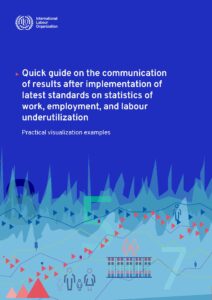
Quick guide on the communication of results after implementation of latest standards on statistics of work, employment, and labour underutilization
A crucial aspect of the implementation of latest labour statistics standards is the effective communication of the results, to ensure getting the best out of the data. This guide aims to provide practical data visualization examples to convey clearly and intuitively the impact of methodological changes on key labour indicators following the implementation of the 19th ICLS resolution and avoid misinterpretation of the results.
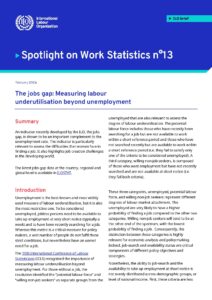
The jobs gap: Measuring labour underutilisation beyond unemployment
This issue of Spolight on Work Statistics discusses an indicator recently developed by the ILO – the jobs gap – which is shown to be an important complement to the unemployment rate. The indicator is particularly relevant to assess the difficulties that women face in finding a job and highlights job creation challenges in the developing world.
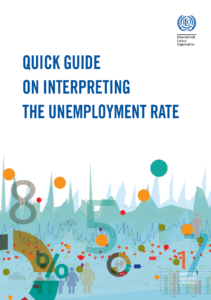
Quick guide on interpreting the unemployment rate
The unemployment rate is a key labour market indicator, but it has many shortcomings which we must take into account when interpreting it. The Quick guide on interpreting the unemployment rate provides helpful information on all the main aspects underlying this headline indicator and its limitations. It also provides tips to communicate effectively on the unemployment rate.

Decent Work and the Sustainable Development Goals: A Guidebook on SDG Labour Market Indicators
This Guidebook provides a detailed overview of the labour market indicators included in the Sustainable Development Goals Global Indicator Framework. It is intended to serve as a manual of best practices for calculating and interpreting the SDG labour market indicators, with a view to monitoring progress made at the national and international levels towards the achievement of the SDGs.
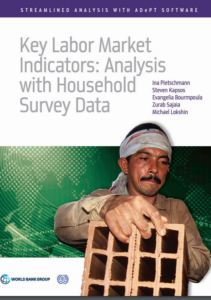
Key Labor Market Indicators: Analysis with Household Survey Data
This publication is an introduction to labour market indicator analysis and a guide for analysing household survey data using the ADePT ILO Labour Market Indicators Module. The ADePT module is a powerful tool for producing and analysing KILM indicators using household survey data. The software allows researchers and practitioners to automate data production, to minimize data production errors and to quickly produce a wide range of labour market data from labour force surveys or other household surveys that contain labour market information.

Decent Work Indicators – Guidelines for producers and users of statistical and legal framework indicators
This manual presents guidelines on the decent work statistical indicators and legal framework indicators. It is divided into eleven chapters which correspond to the ten substantive elements of decent work as well as to the economic and social context for decent work.

Resolution concerning statistics of work, employment and labour underutilization (including amendments)
Adopted by the 19th ICLS (2013), this resolution sets standards for work statistics to guide countries in updating and integrating their existing statistical programmes in this field. It defines the statistical concept of work for reference purposes and provides operational concepts, definitions and guidelines for: (a) distinct subsets of work activities, referred to as forms of work; (b) related classifications of the population according to their labour force status and main form of work; (c) measures of labour underutilization.

Sources and Methods Volume 5: Population censuses (2004) – Total and economically active population, employment and unemployment
This volume is an updated version of the second edition issued in 1996 which presented national methodological descriptions of population censuses carried out during the period 1989-94 in 115 countries, areas and territories. The first edition issued in 1990 covered the period 1945-89.

Sources and Methods Volume 4: Administrative records and related sources (2004) – Employment, unemployment, wages and hours of work
This volume presents national methodological descriptions of statistics of employment, unemployment, wages and hours of work, derived from administrative records and related sources. It is a revised and updated version of the first edition issued in 1989, and contains 124 descriptions in respect of 102 countries, areas and territories.

Sources and Methods Volume 3A: Household surveys (2004) – Economically active population, employment, unemployment and hours of work
This volume presents national methodological descriptions of statistics of employment, unemployment, underemployment, hours of work and other indicators derived from labour force and household surveys, disseminated on ILOSTAT. It is a revised and updated version of the second edition issued in 1990. This third edition contains descriptions for 83 countries.
Publications
Note: Many publications are available only in English. If available in other languages, a new page will open displaying these options.
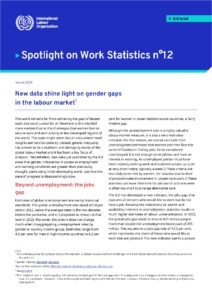
New data shine light on gender gaps in the labour market
A new indicator developed by the ILO finds that women’s access to employment, working conditions and pay gap have barely improved in the past two decades.
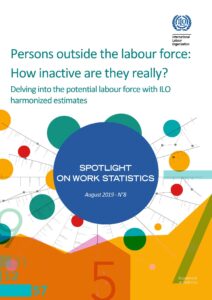
Persons outside the labour force: How inactive are they really?
Inactivity rates are increasing around the world, while the global population and labour force are ageing. But the inactivity rate is an aggregate measure overlooking the different profiles of people outside the labour force. This Spotlight on Work Statistics explores the characteristics of the potential labour force, made up of persons outside the labour force with an attachment to the labour market.
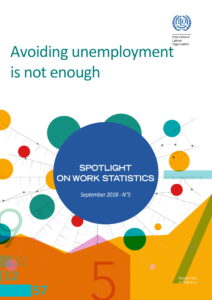
Avoiding unemployment is not enough
Discover the patterns around the world of unemployment and other forms of labour underutilization, including time-related underemployment, the potential labour force and over-education in the fourth issue of our series Spotlight on Work Statistics.

What about seniors?
Learn about the situation of older persons in the labour market in this brief, the first issue of our new series Spotlight on work statistics where we use ILOSTAT data to explore various labour market issues.




